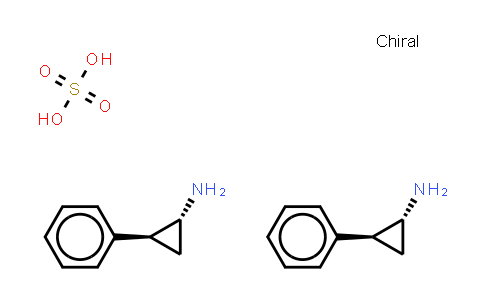| Chemical Name |
Tranylcypromine (hemisulfate) |
| CAS Number |
13492-01-8 |
| MDL Number |
MFCD00079222 |
| Molecular Formula |
C18H24N2O4S |
| Molecular Weight |
364.46 |
| Synonyms |
dl-Tranylcypromine hemisulfate;trans-2-Phenylcyclopropylamine hemisulfate salt |
Introduction of 13492-01-8 :
Tranylcypromine hemisulfate (dl-Tranylcypromine hemisulfate) is an irreversible, nonselective monoamine oxidase (MAO) inhibitor used in the treatment of depression. Tranylcypromine hemisulfate is also a lysine-specific demethylase 1 (LSD1) inhibitor, suppresses lesion growth and improves generalized hyperalgesia in mouse with induced endometriosis. Tranylcypromine has antidepressant effects[1][2]. In Vitro: Tranylcypromine (10 nM to 10 µM) exerts neuroprotective effects against toxicity induced by human Aβ(1-42) oligomers independently from the presence of glial cells[1]. Tranylcypromine (100 μM) significantly protects RGCs from glutamate neurotoxicity-induced apoptosis as well as apoptosis induced by oxidative stress. Tranylcypromine promotes mitogen-activated protein kinase 12 (p38 MAPKγ) expression under conditions of glutamate (Glu)-induced stress. Besides, tranylcypromine contributes to RGC survival via alterations of p38 MAPKγ activity[3]. In Vivo: Tranylcypromine treatment significantly and substantially reduces the lesion size and improves generalized hyperalgesia in a dose-dependent fashion in mice with induced endometriosis. In addition, tranylcypromine treatment results in reduced immunoreactivity to biomarkers of proliferation, angiogenesis, and H3K4 methylation, leading to arrested EMT and lesion growth[2]. Tranylcypromine (500 mM) injection exerts neuroprotective effects within intracellular apoptotic signaling pathways and suppresses morphologic changes in the retina of the rat, suppresses caspase 3 activity and recovers p38 MAPKγ expression in the retina after NMDA-induced injury, and enhances RGC survival after retinal injury via the attenuation of NMDA neurotoxicity[3]. Tranylcypromine (10 µg/g) causes an approximate and significant doubling of labeled cells in the combined brain regions examined, as detected by BrdU immunohistochemistry. Tranylcypromine causes the greatest increase in cell proliferation in the cerebellum[4].
| Purity |
NLT 98% |
| Storage |
at 20ºC 2 years |
*The above information is for reference only.
